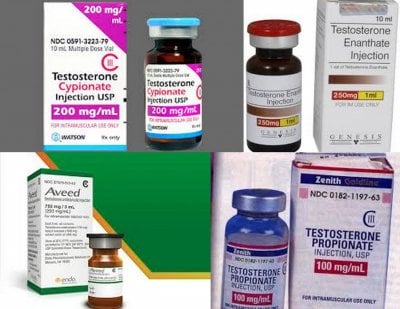Jasen Bruce
Member

The most common forms of injectable testosterone include Testosterone Cypionate, Testosterone Propionate, Testosterone Enanthate, or a compounded 'blend' of different types. I do not like testosterone "blends" do to irregular release patterns especially with once weekly injections. Always remember that each of these types are testosterone, the molecule remains unchanged, and the only difference is the "ester" which determines the half-life within the body. 'Cypionate', 'enanthate', and 'propionate' are all esters. An 'ester' is basically a chain composed of Hydrogen, Carbon, and Oxygen atoms which are attached to the testosterone molecule which must be broken down creating a 'timed release" in the body once injected. Even though the testosterone molecule remains the same no matter the ester, each one can yield slightly different results by the way they are metabolised in the body once injected.
Enanthate: This is metabolized in roughly 4-5 days. It can even remain in the body (in very small amounts) for 2 weeks. 100mg of Testosterone Enanthate yields ~73mg of actual testosterone, the rest is ester weight. Injections can be administered every 5 days. As we all know everyone is unique in their response to drugs but from what I have seen in my experience the approximate starting doses which may bring a patient within optimal ranges (650ng-1100ng) is 100mg-200mg IM every 5-7 days. Of course many factors come into play including the patient's baseline levels and biology.
Cypionate: This is metabolized in roughly 7-8 days. This is also considered a 'long-acting' testosterone. 100mg of Cypionate yields ~68mg of actual testosterone. A good starting dose would be similar to Enanthate, more commonly between 100mg-200mg IM every 7 days.
Propionate: This is a faster acting ester which can peak in the blood within hours and metabolized over 3 days. Injections should be administered every 2-3 days. You must weigh the 'positives' with the 'negatives' before prescribing propionate. Since it metabolizes so quickly, and needs to be administered frequently, it is easy to stabilize levels and optimizes blood-testosterone-levels quickly. On the downside IM injections must be given frequently which can keep patients from remaining compliant. Also, since the levels peak faster there is also an increased chance of aromatizing the testosterone into estrogen and increased DHT conversion which can cause side effects. 100mg of Propionate yields ~93mg of testosterone.
Other Esters found in TRT medicine may include;
Aqueous Testosterone Suspension: No-Ester. Requires frequent IM injections since it remains in the body only for a few hours. (Very painful injection). The risks outweigh the benefits when it comes to Testosterone Suspension and we do not recommend prescribing this particular ester.
We now have Aveed (Nebido outside the US) which is testosterone undecanoate. This is a very long acting ester which is injected every 6-12 weeks with the goal of maintaining adequate T levels. Since this ester is rather new and slowly becoming more prescribed, it is too soon to see how well this protocol actually applies to patients. Much like testosterone pellets which quickly were identified as not releasing in the body as designed, Nebido may be found to have similar significant variations in how it is metabolized between individuals.
Last edited by a moderator:
















